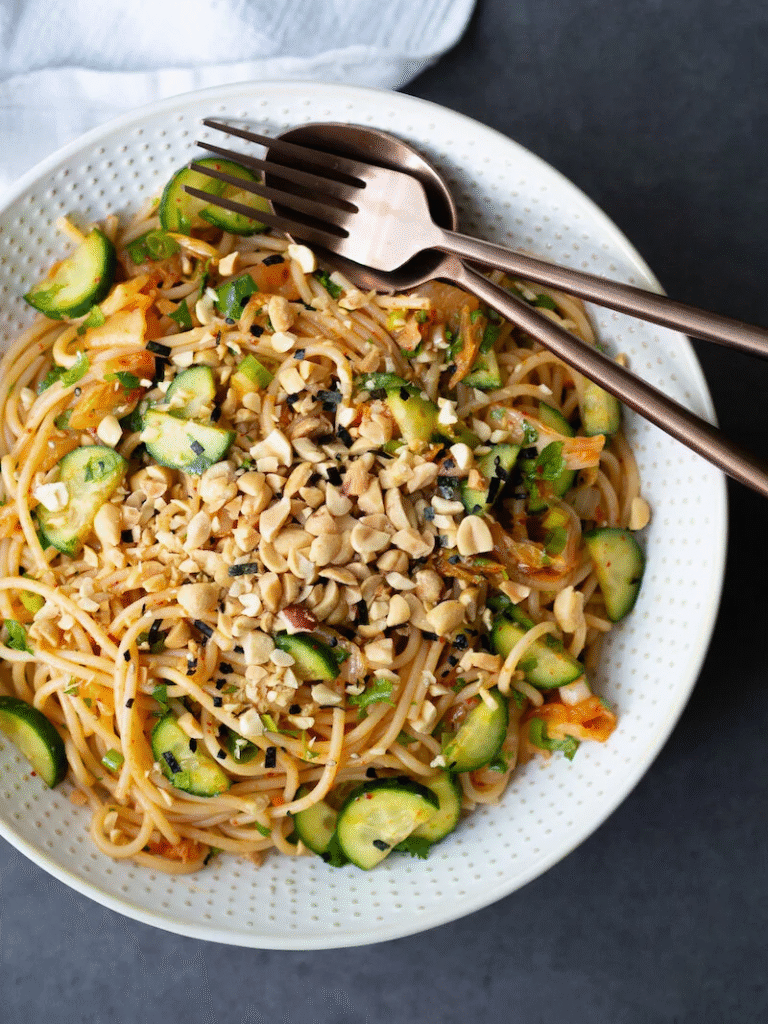Forget everything you know about standard, meek pasta salads. This Spicy Kimchi Noodle Salad is a full sensory experience built on five core elements: the chewy snap of cold noodles, the fermented funk of kimchi, the cooling crunch of fresh vegetables, the intense umami of the sauce, and the non-negotiable blistering heat. This dish should be served aggressively cold—the perfect contrast to the heat from the Gochujang (Korean chili paste). My personal rookie mistake in making noodle salads? Not chilling the noodles immediately after cooking! If you skip the ice-bath shock, the noodles keep cooking, they turn gummy, and the sauce slides right off. We’re learning from that failure. We’re going to treat these noodles like a chef: cooked precisely, shocked, and smothered in a thick, nutty, spicy emulsion that clings to every strand. Get ready for a deeply flavored, satisfying, and cooling blast of Korean-inspired heat.
🎯 QUICK FACTS TABLE
| Component | Time Estimate |
|---|---|
| Prep Time | 10 minutes (Vegetable chopping) |
| Active Cook Time | 8 minutes (Noodles + Egg) |
| Chill Time | 10 minutes (MANDATORY for noodles) |
| Total Time | 28 minutes |
| Servings | 2 Intense Meals or 4 Sides |
| Difficulty | Easy (If you can boil water!) |
📝 INGREDIENTS SECTION
For the Cold & Chewy Base
- 8 oz Somen or Buckwheat Soba Noodles (The thin, fast-cooking kind!)
- 1 tbsp Neutral Oil (Vegetable or Canola)
- 1/2 cup Kimchi (Drained, aggressively chopped, reserving the juice)
- 1/2 cup Thinly Sliced Cucumber (Julienned for maximum crunch)
- 1/4 cup Shredded Carrot (For color and snap)
- 2 Scallions (White and green parts, sliced thinly)
- 2 Hard-Boiled Eggs (Optional, sliced in half for garnish)
For the Gochujang-Peanut Emulsion (The Soul of the Dish)
- 3 tbsp Gochujang (Korean chili paste—use a high-quality jar!)
- 2 tbsp Kimchi Juice (Reserved from the chopped kimchi—this is the umami secret!)
- 1 tbsp Smooth Peanut Butter (Essential for binding and nuttiness)
- 1 tbsp Toasted Sesame Oil
- 1 tbsp Rice Vinegar (For necessary tang)
- 1 tsp Soy Sauce or Tamari (For salty depth)
- 1 tsp Maple Syrup or Honey (To balance the heat)
- 1 clove Garlic (Minced very finely)
For the Essential Garnish (The Finishers)
- 1 tbsp Toasted Sesame Seeds (For texture and aroma)
- 1 tsp Gochugaru (Korean chili flakes, optional, for maximum heat)
👩🍳 HOW TO COOK!
- Cook and Shock the Noodles (The Critical Step): Bring a large pot of water to a rolling boil. Add the Somen or Soba noodles and cook according to package directions until perfectly al dente (usually 4-6 minutes). Immediately drain the noodles and plunge them into an ice bath (a large bowl of cold water and ice). This shock stops the cooking process and firms up the starches, preventing them from becoming mushy. Drain thoroughly and toss with 1 tbsp of neutral oil to prevent sticking.
- Whisk the Emulsion: In a small mixing bowl, combine all the dressing ingredients: Gochujang, reserved kimchi juice, peanut butter, sesame oil, rice vinegar, soy sauce, maple syrup, and minced garlic. Whisk vigorously until the peanut butter is fully incorporated and you have a thick, uniform, intensely red emulsion. Taste it—it should be aggressively spicy, tangy, and sweet.
- Toss and Coat: In your largest mixing bowl, combine the cold, shocked noodles, chopped kimchi, sliced cucumber, shredded carrot, and scallions. Pour the entire Gochujang-Peanut Emulsion over the ingredients. Using tongs, toss aggressively and thoroughly until every single noodle strand is coated in the thick, beautiful red sauce.
- Plate and Garnish: Divide the salad into serving bowls. The salad should look vibrant and shiny. Garnish each serving with the sliced hard-boiled eggs, a sprinkle of toasted sesame seeds, and, if you dare, a few pinches of Gochugaru for an added layer of flaky heat. Serve immediately while the noodles are still cold!
📊 NUTRITION & TIPS
Pro-Tips: Little Tweaks, Big Results
- Substitution/Time Saver: If Somen/Soba noodles aren’t available, high-quality fresh thin spaghetti or linguine (cooked and chilled) is the best stand-in. Avoid thick egg noodles, as their texture is too soft for this recipe.
- Essential Technique Tip: The inclusion of peanut butter is crucial here, not just for flavor, but for texture. It acts as a thickener and emulsifier, preventing the sauce from running off the cold, slick noodles. Do not substitute it with oil; use a small amount of water if you need to thin the dressing slightly.
❓ READERS ASKED, WE ANSWERED
Q: My kimchi juice is super thin and a bit sour. Will that make my dressing runny?
A: You’re encountering highly fermented, good-quality kimchi! Thin, sour juice is a sign of great flavor, but you are right—it will thin the dressing. Here’s the fix: if your kimchi juice is thin, reduce the rice vinegar by half and add 1/2 teaspoon more peanut butter to the dressing. Alternatively, you can briefly warm the kimchi juice on the stove until it reduces slightly and concentrates its flavor, before letting it cool and adding it to the emulsion. This will ensure your sauce is both intensely flavorful and thick enough to cling to the noodles.
